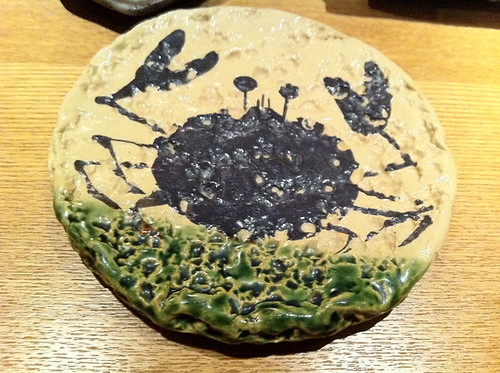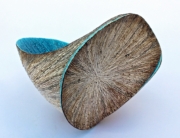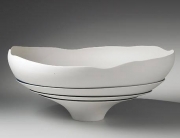The name of Oribe Yaki is rather unique. It’s actually named after a single individual. Furuta Shigenari (1544-1615) was a warrior who once served Toyotomi Hideyoshi and Oda Nobunaga. He became the foremost tea master when his teacher Sen no Rikyu perished.
Furuta taught the ceremony to the shogun Tokugawa Hidetada and gained the honorific name Oribe. He was so influential in tea ceremony yakimono pieces that the style continues to carry his name.
Considering that he seemed to retire to a pleasant life of artistic expression, one might assume that Oribe would have quietly focused on his ceramics and stone toro lanterns. However, he collected a salary of around 10,000 koku in 1600. He plotted against major powerbrokers during the Osaka Campaign and later took his own life.

Individual Oribe Ceramic Pieces Often Look Like Folk Art
As might be expected with a style that has such an interesting story behind it variations are the key when taking about Oribe ware. Subject matter covers a wide array of household items. As well as bowls and dishes, Oribe ware jars and canisters are relatively common. In the days before mechanical refrigeration these objects were needed to preserve food.
Most Oribe yakimono pieces have a brilliant green color. This comes from the fact that they were fired inside of an oxidation atmosphere at around 1,220 degrees Centigrade. Glazes could end up red or brown if these exacting conditions weren’t met correctly.
Artists generally selected clays that had low iron content. They formed most pieces by hand or on a potter’s wheel. Some drape molding pieces can also be found in art galleries today. Oribe ware often had additional surface paint layers that featured rather eccentric designs.
Some of these featured rather simple geometric patterns while others featured nature scenes, and as time went on these two traditions were merged. While Oribe yakimono ware is a product of the 16th century Mino movement, it was never stuck in certain traditions.

Identifying Oribe Pieces can be Challenging but Well Worth the Time
Experimental styles gave artists new media to work with. Clear glazes were used on later pieces. The green copper glazes on Oribe ware were probably the first colored stoneware glazes ever used by native Japanese potters. That meant that they were ready to try out different designs. Individuals who really want to research the history of Oribe pieces will actually be able to locate some examples that use white slip.
Some pieces show characteristic brown lines that are a product of the manufacturing process. These imperfections should not be scoffed at. Some artists considered them a real thing of pride.




